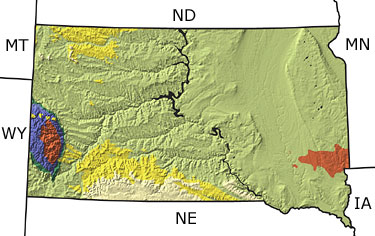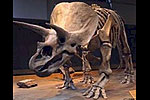South Dakota, US
|
|
|||||||||||||||||||||||||||||||||||||||||||||||||||||||||||||
Paleontology and geology
The Precambrian: Precambrian rocks are exposed in the Black Hills in the western part of the state and in the Sioux Arch in eastern South Dakota. All of these rocks are metamorphic; no fossils have been found in them to date.
The Paleozoic: A shallow sea flooded South Dakota in the early Paleozoic, depositing a sequence of progressively finer-grained layers of sediment. Trace fossils are abundant in the Cambrian rocks of the state. Fossils of corals, brachiopods, cephalopods, and other invertebrates indicate that marine conditions continued through the early to middle Paleozoic, interrupted by brief intervals during the Ordovician when the sea withdrew, leaving the state exposed to erosion. The late Paleozoic (Carboniferous) was again a time of fluctuating sea levels across the state: fossils of brachiopods and corals, and the presence of evaporites and coal deposits, are evidence that marine, brackish, and fresh water conditions existed at various times through this interval. Sea level dropped during the Permian, once more leaving South Dakota exposed to erosion.
The Mesozoic: South Dakota was covered by humid coastal plains and intertidal mudflats during the early Mesozoic (Triassic). The sea again flooded the state in the middle Mesozoic (Jurassic), leaving behind a rock record that includes fossils of clams, ammonites, crinoids, and starfish. Lakes, swamps, and streams developed over the landscape as the sea retreated later in the Jurassic. The sedimentary rocks formed in these environments contain abundant plant fossils and the remains of giant sauropod dinosaurs. During the late Mesozoic (Cretaceous), a great seaway developed, once more covering much of South Dakota with marine waters. This seaway was home to abundant invertebrates, marine reptiles, and aquatic birds, while dinosaurs, small mammals, and birds inhabited the shores and inland areas. The Black Hills of western South Dakota were uplifted during this time.
The Cenozoic: The Black Hills continued to rise during the early Cenozoic (Tertiary), while the last invasion of marine water over South Dakota occurred in the central and eastern parts of the state. As the Cenozoic progressed, the sea gradually withdrew from the state and was replaced by expanding grasslands inhabited by numerous grazing mammals. Layers of ash incorporated in early Cenozoic rocks across the state indicate that this was a time of volcanic activity. In the late Cenozoic (Quaternary), ice sheets advanced and retreated across South Dakota. Gravels and sands left behind by the melting ice contain numerous fossils of bison, mammoth, mastodon, and horse. Erosional processes increased during the Late Quaternary and continue to modify the surface of South Dakota today.
Links to more on South Dakota paleontology
Organizations | Education and Exhibits | Research and Collections | Resources
OrganizationsEducation and ExhibitsParks (showing 1 of 1 listings)
Badlands National Park: Located in South Dakota, Badlands National Park is a trove of Miocene vertebrate fossils.
Museums (showing 2 of 2 listings)
The Mammoth Site: This site provides information about the site itself, the world's largest mammoth research facility, and provides a virtual tour and information on the geology of the site.
South Dakota Museum of Geology: This site describes the collections and exhibits of this museum, which has a mission to conserve the geological heritage of South Dakota.
Colleges and Universities (showing 3 of 3 listings)
South Dakota School of Mines and Technology: Undergraduate and Graduate courses in paleontology
University of South Dakota, Earth Sciences Program: General information about the Earth Sciences Program, including undergraduate and graduate courses in paleontology
Paleontology Club at South Dakota School of Mines: The Paleontology Club is an educational, scientific, and non-profit organization dedicated to promoting paleontology in the community. paleoclub.com contains a weblog that chronicles events and research in Paleontology at the South Dakota School of Mines & Technology and Museum of Geology in Rapid City South Dakota
Research and CollectionsVirtual Exhibits (showing 2 of 2 listings)
Sue at Chicago's Field Museum of Natural History: Excavated in South Dakota and now on display in Chicago, Sue is the world's largest, most complete, and best preserved Tyrannosaurus rex. Take a tour of this website for detailed information about Sue.
Dinosaurs of South Dakota: This site provides an overview of the dinosaurs that lived in South Dakota during the Jurassic and Cretaceous.
ResourcesOngoing Research Projects (showing 1 of 1 listings)
Big Sioux River: Descriptions, photos and maps showing the Big Sioux River geology, origin, flora and fauna, with emphasis on Sioux Quartzite formations.
Field Guides (showing 1 of 1 listings)
Oceans of Kansas: Photographs, artwork, historical papers, and other information on the sea creatures, especially mosasaurs and plesiosaurs, that lived in the Western United States during the Cretaceous period.

